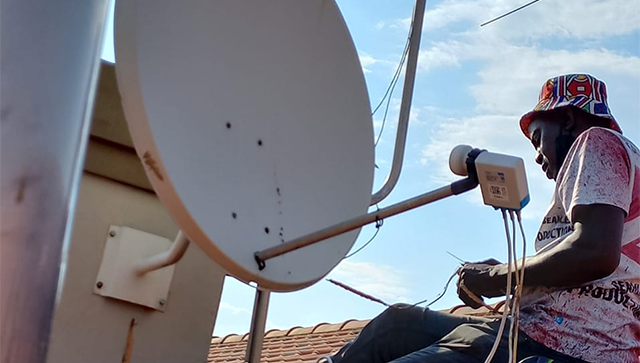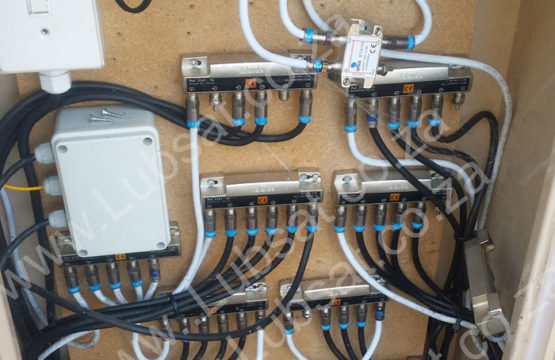DStv Setup Facilitated with HDTEC Innovation
DStv Setup Facilitated with HDTEC Innovation
Blog Article
The Ultimate Overview to DSTV Installment: Why Proper Configuration Is Important for Optimal Watching Experience
The setup of a DSTV system is a procedure that demands accuracy and expertise, as the quality of setup straight influences the overall viewing experience. Correct alignment of vital elements, such as the satellite dish and the LNB, is crucial to make sure ideal signal reception and protect against typical concerns like pixelation. Understanding the significance of adhering to sector standards can secure warranties and lessen future difficulties. As we discover the ins and outs of DSTV installation, it ends up being evident that even small oversights can result in substantial consequences, triggering a more detailed examination of necessary arrangement techniques.
Relevance of Appropriate Installment
Appropriate installment of DSTV systems is critical for ensuring ideal performance and dependability. A properly established system not only enhances the seeing experience but also minimizes potential technological issues that can emerge throughout use. The alignment of satellite dishes, the quality of cable links, and the positioning of decoder systems substantially influence signal strength and high quality.
Insufficient setup can bring about usual issues such as bad image quality, periodic signal loss, and total service interruptions. These concerns can be annoying for customers and may call for costly repair services or reinstallation solutions. Incorrect installment can nullify warranties and lead to extra expenses down the line.
Furthermore, professional installment guarantees conformity with safety criteria and guidelines, decreasing risks connected with electric faults or architectural concerns. It likewise permits for the potential of future upgrades, as a tactical installation can fit advancements in innovation seamlessly.
Eventually, spending time and resources into correct DSTV installation is vital for enjoying undisturbed accessibility to a wide variety of entertainment choices, while additionally safeguarding the integrity of the system for many years ahead.
Key Components of DSTV Configuration
At the heart of an effective DSTV setup are a number of crucial parts that collaborate to provide high-quality viewing experiences. The first necessary component is the satellite dish, which catches signals transferred from satellites orbiting the Planet. Typically, a 60cm or 90cm meal is utilized, relying on the area and signal strength needed.

The decoder, or set-top box, is another essential component, as it translates the signals and facilitates access to numerous channels and functions. The selection of decoder may vary based upon the package selected, affecting the array of channels offered to the visitor.
Lastly, the cabling that links these parts must be of excellent quality to lessen signal loss. Proper installment of these key elements makes sure a seamless watching experience, allowing individuals to appreciate a wide range of amusement without interruptions.

Satellite Recipe Positioning Methods
Effective positioning of the dish antenna is crucial for optimum signal reception and total performance of the DSTV arrangement. To achieve this, numerous methods need to be utilized. Initially, determine the correct azimuth, altitude, and skew angles required for your area. This information can normally be obtained with DSTV's official setup standards or online sources.
Next, select an installing area that offers an unhampered line of sight to the satellite. It is necessary to avoid any type of possible blockages, such as trees, buildings, or other frameworks, that can interfere with signal reception. HDTEC. When installing the recipe, ensure it is securely secured to stand up to wind and weather
Once the dish is mounted, adjust the placement by utilizing a signal meter. This device helps in discovering the stamina of the satellite signal, permitting specific changes. Gradually tilt and rotate the dish until the most effective signal stamina is accomplished. After confirming optimal positioning, tighten all screws and links to keep security. Appropriate setup not only boosts checking out high quality yet also makes sure long life and integrity of the DSTV solution.
Typical Setup Mistakes
Even a slight imbalance can lead to weak signals, resulting in pixelation or full signal loss. Furthermore, overlooking to secure all links can lead to recurring solution interruptions; loose cable televisions can disrupt signal transmission.
Another constant error is overlooking the importance of cord high quality. Utilizing substandard or incompatible cords may create signal deterioration, adversely influencing your viewing experience. Similarly, falling short to consider the installment environment can lead to obstructions that prevent signal reception. Positioning the dish near tall trees Click Here or buildings can obstruct the line of view to the satellite.
In addition, incorrectly setting up the decoder settings can lead to a frustrating experience. Individuals typically forget the need to choose the ideal satellite or frequency setups, which can prevent channels from displaying properly. HDTEC. Last but not least, some installers undervalue the importance of basing the system, which can cause devices damages during electrical storms.
Dealing with these common installation mistakes is crucial for ensuring a smooth and enjoyable DSTV viewing experience. Correct focus to information during setup can conserve time and improve general fulfillment.
Tips for Signal Optimization
To accomplish optimal signal top quality for your DSTV configuration, it is critical to carry out a number of essential strategies (HDTEC). Initially, make sure that the dish antenna is correctly straightened with the signal source. Use a signal meter throughout installment to tweak the dish's placement, aiming for the toughest possible signal strength
Following, consider the kind of cable television used for links; top quality coax cables minimize signal loss. Prevent long cable television runs, as the longer the range, the higher the possibility for signal deterioration. If longer wires are required, decide for an amplifier to improve the signal.
Additionally, make sure that all links are protected and without rust. Weatherproofing these links can additionally protect them from ecological variables that might disrupt signal high quality.
Last but not least, frequently examine for obstructions that may emerge, such as tree branches or buildings, which can block the line of sight to the satellite. Keeping a clear read course makes sure nonstop service. By following these ideas, you can considerably improve your viewing experience and lessen interruptions in solution high quality.
Conclusion
Thorough interest to crucial components, including the satellite recipe, LNB, and decoder, dramatically boosts signal reception and picture quality. Sticking to suggested installation techniques decreases the danger of common mistakes and the original source maximizes signal performance.
Report this page